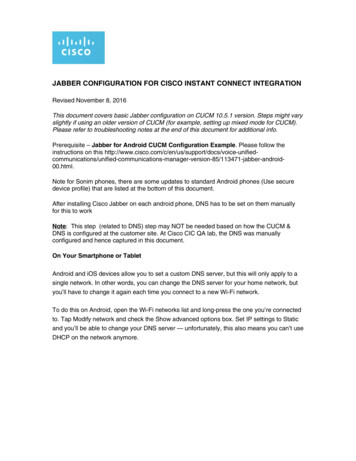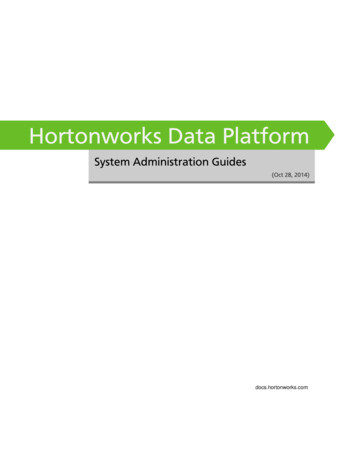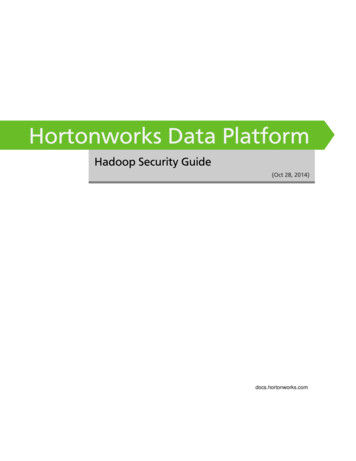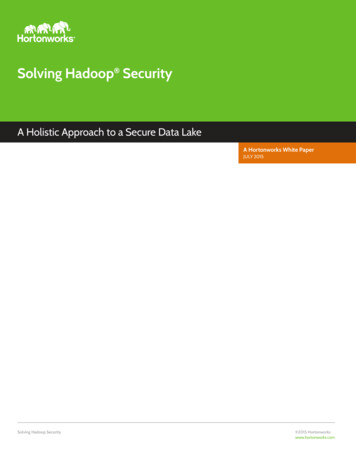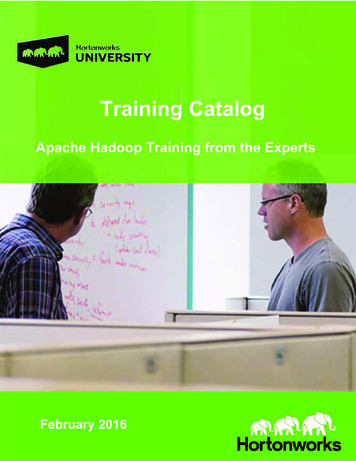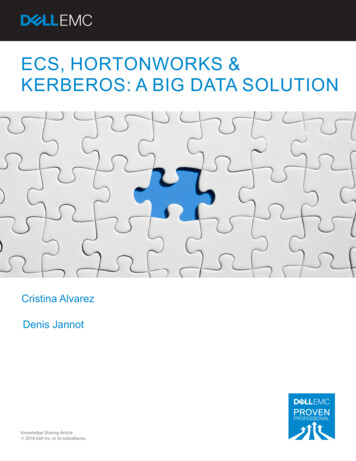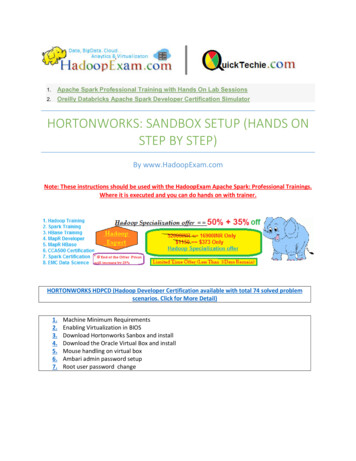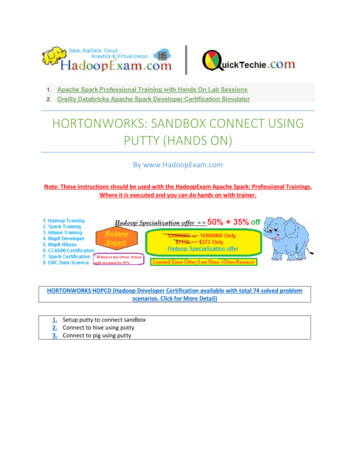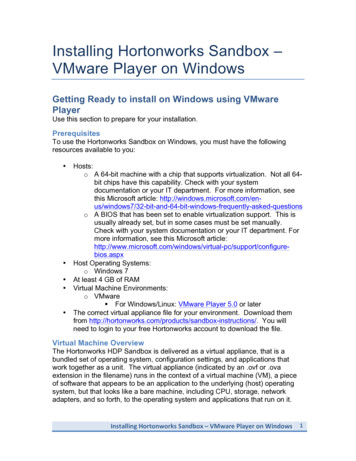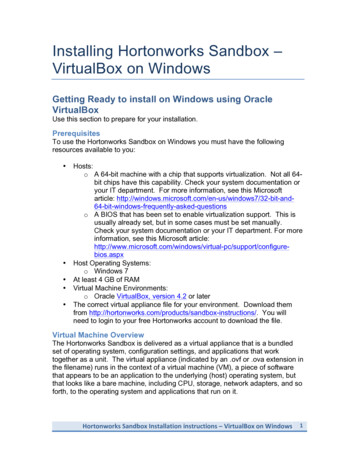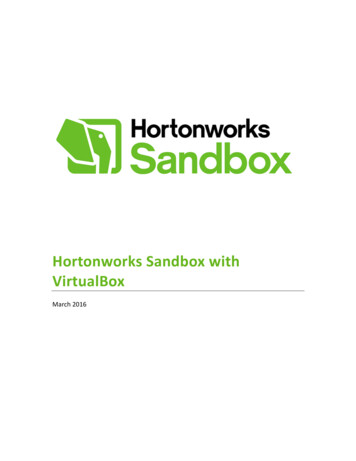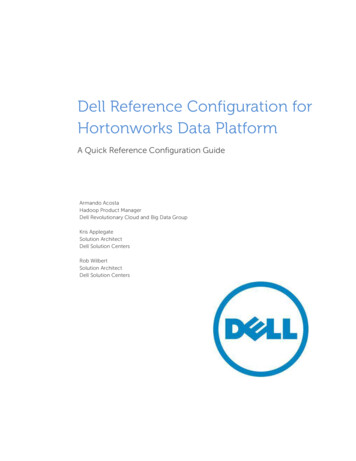
Transcription
Dell Reference Configuration forHortonworks Data PlatformA Quick Reference Configuration GuideArmando AcostaHadoop Product ManagerDell Revolutionary Cloud and Big Data GroupKris ApplegateSolution ArchitectDell Solution CentersRob WilbertSolution ArchitectDell Solution Centers
Executive SummaryThis document details the configuration set-up for Hortonworks Data Platform (HDP)software on the PowerEdge R720XD. The intended audiences for this document arecustomers and system architects looking for information on configuring Apache Hadoopclusters within their information technology environment for big data analytics.The reference configuration introduces the server set-up that can run the Hortonworksstack. The document will only focus on configuration; it will not go into detail aboutHadoop solution components or resiliency, performance, or software considerations. Thisdocument does not focus on best practices or complete architecture for a HortonworksData Platform Solution.Dell developed this document to help streamline configuration for the Hortonworks DataPlatform software.THIS WHITE PAPER IS FOR INFORMATIONAL PURPOSES ONLY, AND MAY CONTAINTYPOGRAPHICAL ERRORS AND TECHNICAL INACCURACIES. THE CONTENT IS PROVIDED AS IS,WITHOUT EXPRESS OR IMPLIED WARRANTIES OF ANY KIND. 2013 Dell Inc. All rights reserved. Reproduction of this material in any manner whatsoever withoutthe express written permission of Dell Inc. is strictly forbidden. For more information, contact Dell.Dell, the DELL logo, and the DELL badge are trademarks of Dell Inc. Intel and Xeon are registeredtrademarks of Intel Corp. Red Hat is a registered trademark of Red Hat Inc. Linux is a registeredtrademark of Linus Torvalds. Other trademarks and trade names may be used in this document torefer to either the entities claiming the marks and names or their products. Dell Inc. disclaims anyproprietary interest in trademarks and trade names other than its own.2Dell Reference Configuration for Hortonworks
Reference ConfigurationHortonworks Data Platform is available on both Linux and, in partnership with Microsoft,on Windows. This initial configuration will target deployment on bare-metal serversrunning RedHat Linux 6.x.Server Roles1Name Node(s) – Name nodes serve as control nodes for the HDFS, MapReduce, andHBase processes. For HDFS, name nodes own the block map and directory tree for all thedata on the cluster. With MapReduce, the name node owns the job tracking daemon(JobTracker) that handles job execution and monitoring. Lastly, with HBase, name nodesare responsible for running the monitoring processes as well as owning any metadataoperations. In addition to a primary name node, a secondary name node is stronglyrecommended for any deployment beyond a proof-of-concept.Data Node(s) – Data nodes are the nodes that hold the data as well as executeMapReduce jobs. Data nodes are generally filled with large amounts of local disk, enablingthe parallel processing and distributed storage features of Hadoop. The number of datanodes is dictated by use case. Adding additional data nodes increases both performanceand capacity simultaneously. Maintaining a 1:1 ratio of CPU cores to disk spindles can beimportant in many high I/O workloads.Edge Node(s) – Edge nodes lie on the perimeter of the dedicated Hadoop network andbridge the Hadoop environment with the production IT environment. Edge nodes enableexternal users and business processes to interact with the cluster. Additional edge nodesmay be added to the Hadoop cluster as external access requirements increase.Ambari Manager Node – The Ambari management node is where the Ambari serverresides. The Ambari management node runs the configuration management processes,web server software, monitoring software (open-source project Nagios) and performancemonitoring (open-source project Ganglia) software. In a production environment, theAmbari server should run on a dedicated node; however, for the purposes of thisdocument, Ambari server was installed on the edge node.13In Hortonworks terminology the Name Node can be referred to as the Master NodeDell Reference Configuration for Hortonworks
Figure 1.Dell Big Data Cluster Logical DiagramNode Count RecommendationsDell recognizes that use-cases for Hadoop range from small development clusters all theway through large multi petabyte production installations. Dell has a Professional Servicesteam that sizes Hadoop clusters for a customer’s particular use. As a starting point, threecluster configurations can be defined for typical use:Minimum Development Cluster – The minimum development cluster is targeted atfunctional testing and may even be built from existing equipment; however, theperformance of these types of clusters can be significantly less as development clusterstypically do not benefit from the highly distributed nature of HDFS.Recommended Small Cluster – The recommended small cluster is a good starting pointfor customers taking the initial steps for running HDP in production. A small clusterprovides some layers of basic resiliency that is expected in today’s production IT world.Recommended Production Cluster – The recommended production clusterconfiguration provides dense storage and compute capacity, coupled with high degree ofresiliency. The production cluster allows for an adequate number of data nodes todemonstrate the performance benefits of distributed storage and parallel computing.4Dell Reference Configuration for Hortonworks
Table 1.Recommended Cluster SizesMinimum r3120212602RecommendedProduction Cluster211141Name Node(s)Job Tracker(s)Edge Node(s)Data Node(s)Ambari ManagementNode1 GbE Switches11210 GbE Switches022Rack Units9U19U42U1In this case a single node serves as the name node, job tracker, edge node and Ambari managementnode.2In this case the Ambari management node, job tracker, and edge node roles are combined.3Configurations include high availability and resiliency which is recommended for production clusters,proof of concepts and small cluster can exclude high availability and resiliencyFigure 2.5Reference Configuration DiagramDell Reference Configuration for Hortonworks
Figure 3.Ambari Manager - Node InstallationTested ConfigurationFor the purposes of this document, a small Hadoop cluster was deployed asrecommended in Table 1. The specific software revisions used in the test are shown inTable 2. The PowerEdge R720 and R70XD hardware configurations we tested are shown inTable 3 and Table 4. The hardware listed should be used as initial guidance only.Additional configurations are possible and will likely be required as each customer’senvironment and use-case is unique. Common parameters that could differ include:Processors – Higher frequencies and core counts may improve performance whilelower voltage/TDP processors, such as the Intel Xeon E5-2630L processor, canimprove power efficiency2. Local Storage – Disk capacity, drive technology, and spindle speed can be matched tobudget and performance requirements as necessary3. Memory – Depending on the usage of various services (Hbase versus Map Reduce)more or less memory may be necessary on both the infrastructure and data nodes1.Teragen / TerasortThese two HDFS / MapReduce benchmarks are used in conjunction with each other tostress Hadoop systems and provide valuable metrics with regards to network, disk andCPU utilization. By starting with these benchmarks as a baseline, Hadoop administratorscan tune Hadoop’s wide variety of parameters to achieve the desired performance.Teragen starts by generating flat text files that contain pseudo-random data that Terasortthen sorts. This type of sort / shuffle exercise simulates customer workloads as theymanipulate data through MapReduce jobs.6Dell Reference Configuration for Hortonworks
Figure 4.Table 2.Ambari Manager MonitoringSoftware Revisions (As Tested)ComponentRedhat Enterprise LinuxHortonworks Data Platform HadoopHadoopTable 3.PowerEdge R720 Infrastructure Node Configuration (As ID ControllerManagement CardTable 4.7Revision6.41.31.2.0Specification2 Rack Units (3.5”)2x Intel Xeon E5-2650 2 GHz 8-core processors128 GB6x 600 GB 15K SAS Drives4x 1GbE Intel LOMs, 2x 10GbE Intel NICsPowerEdge RAID Controller H710 (PERC)Integrated Dell Remote Access Controller (iDRAC)PowerEdge R720XD Data Node Configuration (As ID ControllerSpecification2 Rack Units (3.5”)2x Intel Xeon E5-2667 2.9 GHz 6-core processors64 GB24x 500GB or 1TB 7200 RPM Nearline SAS drives4x 1GbE Intel LOMs, 2x 10GbE Intel NICsPowerEdge RAID Controller H710 (PERC)Management CardIntegrated Dell Remote Access Controller (iDRAC)Dell Reference Configuration for Hortonworks
Dell Solution CentersThe Dell Solution Centers are a global network of connected labs that allow Dell to helpcustomers architect, validate and build solutions. With multiple footprints in every region,they help customers understand anything from simple hardware platforms, to morecomplex solutions. These engagements range from an informal 30-60 minute briefing,through a longer half-day workshop, and on to a proof-of-concept that allow customersto kick the tires of their solution prior to signing on the dotted line. Customers may engagewith their account team and have them submit a request to take advantage of these freeservices.LinksHortonworks – http://hortonworks.comHortonworks Data Platform - http://hortonworks.com/products/hdp/Hortonworks Sandbox - x/8Dell Reference Configuration for Hortonworks
Dell Reference Configuration for Hortonworks Data Platform A Quick Reference Configuration Guide Armando Acosta Hadoop Product Manager Dell Revolutionary Cloud and Big Data Group Kris Applegate Solution Architect Dell Solution Centers Rob Wilbert So
